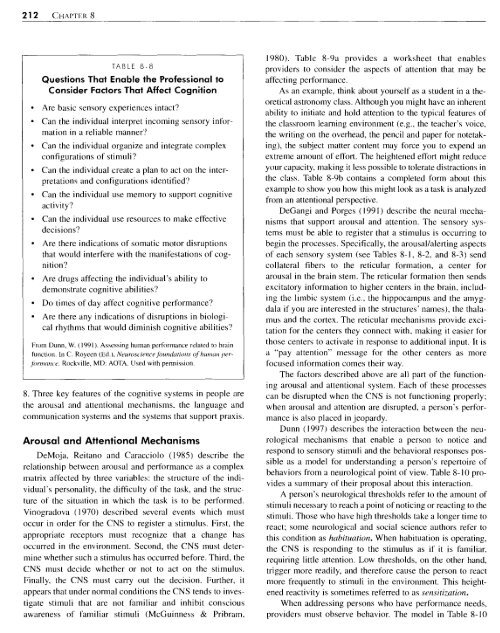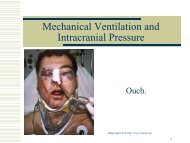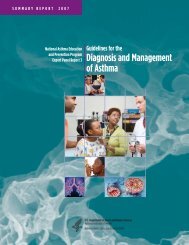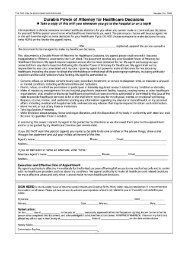Implementing Neuroscience Principles to Support Habilitation and ...
Implementing Neuroscience Principles to Support Habilitation and ...
Implementing Neuroscience Principles to Support Habilitation and ...
Create successful ePaper yourself
Turn your PDF publications into a flip-book with our unique Google optimized e-Paper software.
TABLE 8-8<br />
Questions That Enable the Professional <strong>to</strong><br />
Consider Fac<strong>to</strong>rs That Affect Cognition<br />
Are basic sensory experiences intact<br />
Can the individual interpret incoming sensory information<br />
in a reliable manner'<br />
Can the individual organize <strong>and</strong> integrate complex<br />
configurations of stimuli<br />
Can the individual create a plan <strong>to</strong> act on the interpretations<br />
<strong>and</strong> configurations identified'<br />
Can the individual use memory <strong>to</strong> support cognitive<br />
activity<br />
Can the individual use resources <strong>to</strong> make effective<br />
decisions<br />
Are there indications of somatic mo<strong>to</strong>r disruptions<br />
that would interfere with the manifestations of cognition<br />
Are drugs affecting the individual's ability <strong>to</strong><br />
demonstrate cognitive abilities<br />
Do times of day affect cognitive performance<br />
Are there any indications of disruptions in biological<br />
rhythms that would diminish cognitive abilities<br />
From Dunn, W. (109 1 ). Assessing human performance related <strong>to</strong> brain<br />
functicm. In C. Royeen (Ed.), Nruro.scirnce,fo[~ncIc~~ic~~i.s of hurrrotr 11er-<br />
,fOrmrrrrc~e. Rockville, MD: AOTA. Used with permission.<br />
8. Three key features of the cognitive systems in people are<br />
the arousal <strong>and</strong> attentional mechanisms. the language <strong>and</strong><br />
communication systems <strong>and</strong> the systems that support praxis.<br />
Arousal <strong>and</strong> Attentional Mechanisms<br />
DeMoja, Reitano <strong>and</strong> Caracciolo (1985) describe the<br />
relationship between arousal <strong>and</strong> performance as a complex<br />
matrix affected by three variables: the structure of the individual's<br />
personality, the difficulty of the task, <strong>and</strong> the structure<br />
of the situation in which the task is <strong>to</strong> be performed.<br />
Vinogradova (1970) described several events which must<br />
occur in order for the CNS <strong>to</strong> register a stimulus. First, the<br />
appropriate recep<strong>to</strong>rs must recognize that a change has<br />
occurred in the environment. Second, the CNS must determine<br />
whether such a stimulus has occurred before. Third, the<br />
CNS must decide whether or not <strong>to</strong> act on the stimulus.<br />
Finally, the CNS must carry out the decision. Further, it<br />
appears that under normal conditions the CNS tends <strong>to</strong> investigate<br />
stimuli that are not familiar <strong>and</strong> inhibit conscious<br />
awareness of familiar stimuli (McGuinness & Pribram,<br />
1980). Table 8-9a provides a worksheet that enables<br />
providers <strong>to</strong> consider the aspects of attention that may be<br />
affecting performance.<br />
As an example, think about yourself as a student in a theoretical<br />
astronomy class. Although you might have an inherent<br />
ability <strong>to</strong> initiate <strong>and</strong> hold attention <strong>to</strong> the typical features of<br />
the classroom learning environment (e.g., the teacher's voice,<br />
the writing on the overhead, the pencil <strong>and</strong> paper for notetaking),<br />
the subject matter content may force you <strong>to</strong> expend an<br />
extreme amount of effort. The heightened effort might reduce<br />
your capacity. making it less possible <strong>to</strong> <strong>to</strong>lerate distractions in<br />
the class. Table 8-9b contains a completed form about this<br />
example <strong>to</strong> show you how this might look as a task is analyzed<br />
from an attentional perspective.<br />
DeGangi <strong>and</strong> Porges (1991) describe the neural mechanisms<br />
that support arousal <strong>and</strong> attention. The sensory systems<br />
must be able <strong>to</strong> register that a stimulus is occurring <strong>to</strong><br />
begin the processes. Specifically, the arousallalerting aspects<br />
of each sensory system (see Tables 8-1, 8-2, <strong>and</strong> 8-3) send<br />
collateral fibers <strong>to</strong> the reticular formation, a center for<br />
arousal in the brain stem. The reticular formation then sends<br />
excita<strong>to</strong>ry information <strong>to</strong> higher centers in the brain. including<br />
the limbic system (i.e., the hippocampus <strong>and</strong> the amygdala<br />
if you are interested in the structures' names), the thalamus<br />
<strong>and</strong> the cortex. The reticular mechanisms provide excitation<br />
for the centers they connect with. making it easier for<br />
those centers <strong>to</strong> activate in response <strong>to</strong> additional input. It is<br />
a "pay attention" message for the other centers as more<br />
focused information comes their way.<br />
The Fac<strong>to</strong>rs described above are all part of the functioning<br />
arousal <strong>and</strong> attentional system. Each of these processes<br />
can be disrupted when the CNS is not functioning properly;<br />
when arousal <strong>and</strong> attention are disrupted, n person's performance<br />
is also placed in jeopardy.<br />
Dunn (1997) describes the interaction between the neurological<br />
mechanisms that enable a person <strong>to</strong> notice <strong>and</strong><br />
respond <strong>to</strong> sensory stimuli <strong>and</strong> the behavioral responses possible<br />
as a model for underst<strong>and</strong>ing a person's reper<strong>to</strong>ire of<br />
behaviors from a neurological point of view. Table 8- 10 provides<br />
a summary of their proposal about this interaction.<br />
A person's neurological thresholds refer <strong>to</strong> the amount of<br />
stimuli necessary <strong>to</strong> reach a point of noticing or reacting <strong>to</strong> the<br />
stimuli. Those who have high thresholds take a longer time <strong>to</strong><br />
react; some neurological <strong>and</strong> social science authors refer <strong>to</strong><br />
this condition as habituation. When habituation is operating,<br />
the CNS is responding <strong>to</strong> the stimulus as if it is familiar.<br />
requiring little attention. Low thresholds, on the other h<strong>and</strong>,<br />
trigger more readily, <strong>and</strong> therefore cause the person <strong>to</strong> react<br />
more frequently <strong>to</strong> stimuli in the environment. This heightened<br />
reactivity is sometimes referred <strong>to</strong> as sensitization.<br />
When addressing persons who have performance needs,<br />
providers must observe behavior. The model in Table 8-10





